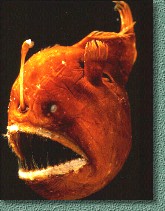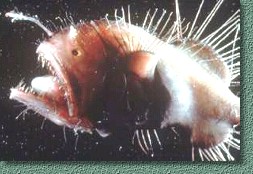Another unusual adaptation in anglerfish is their sexual dimorphism. The males are very small in comparison with the females, and live as permanent parasites on the female. The male attaches himself, by biting, to the body of the female. His mouth fuses with her skin, and the bloodstreams of the two fishes become connected. The male is now totally dependent on the female for nourishment. In fact, the male begins to degenerate. His eyes grow smaller and he eventually loses them. His internal organs disappear.The male becomes simply a source of sperm.  Most deep sea anglers have soft bones, jelly-like flesh, and are dark grey or reddish-black in colour. This colouration serves a purpose ... the only light on the sea bottom comes from luminous creatures, and most of that is blue. The dark skin of the anglerfish absorbs this light and doesn't reflect it, so it remains invisible in the blackness, waiting for prey to go after its lure. Most deep sea anglers have soft bones, jelly-like flesh, and are dark grey or reddish-black in colour. This colouration serves a purpose ... the only light on the sea bottom comes from luminous creatures, and most of that is blue. The dark skin of the anglerfish absorbs this light and doesn't reflect it, so it remains invisible in the blackness, waiting for prey to go after its lure. The 'bait' it dangles on the end of its front spine lights up because at the depth where the anglerfish lives, it is too dark for it to be visible otherwise. Millions of light-producing bacteria inside the lure cause it to light up. |
